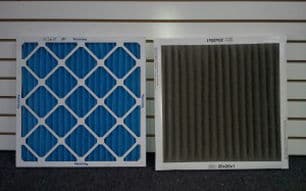The best thing a homeowner can do to for their heating and cooling system is to check/change the filter(s) between regular service visit. This doesn’t replace scheduled maintenance by your trained professional, but will improve the air you breath and cost of operating your comfort system.
First, we should point it out that the A/C filter and furnace filter are one and the same.
Your heating system and cooling system share the same fan and filtration. To move air through your home or business year round.
There are no special tools or skills needed to replace your filter. The filter will be located in a filterrack of the returning air ducts or inside the furnace/air handler. If it looks discolored or dirty replace it with a new filter. When replacing note the air direction on the new filter. The arrow or wire side of the filter should be facing the fan motor in your system. Remember to date the new filter for future reference.
A dirty filter impedes airflow. That’s easy to understand but the effects may not be so easy. Proper airflow is needed to efficiently transfer heat in both cooling and heating modes. Low airflow decreases the efficiency of the system which cost you money and increases your carbon footprint.
Less air movement across the filter leaves more dust, dirt and pollen in the house for you to breath. The air movement also cools your fan motor protecting it from overheating and premature failure.
Some symptoms of a dirty filter are:
• frozen system with no cooling
• tripping the “high limit” and shutting down the furnace
• motor failure
• dirty inside air
• unable to maintain temperature
• poor air circulation
How often you need to replace the filter(s) in your comfort system is mainly determined by the operating environment and run time. The general “rule of thumb” is about every three months. Things like an older inefficient system, poorly insulated house, a high pollen count, maybe you like it cooler or warmer than most, have pets or active children will all decrease the useful life of a filter and require more frequent changes.
When selecting a filter, start with the MERV (minimum effective reporting value) rating:
• 1-4: low quality flat (most washable) filters. They do little to clean the air or protect your equipment trapping particles larger than 10 microns.
• 5-8: medium quality pleated filters. Sufficient for most needs. They filter down to 3 microns which will catch most mold spores
• 9-12: high quality pleated filters. Great for allergies, asthma, and respiratory conditions.
• 12-20: generally used for hospital and food processing. Not recommended for residential applications due to airflow restriction.
If you have questions about anything we discussed here, please give us a call we will be glad to help.


